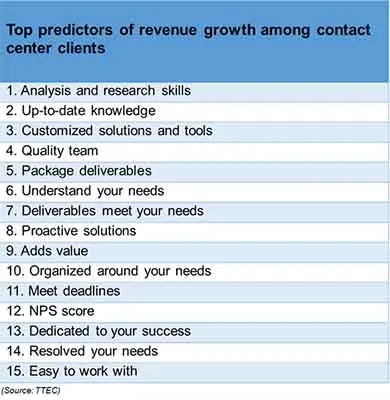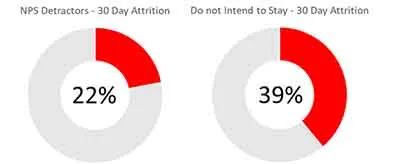When Net Promoter Score (NPS) burst on the scene nearly 20 years ago, it gave companies struggling to measure customer satisfaction a single metric to both identify current sentiment and predict future behavior.
“Would you recommend our company to a friend?” This single question eliminated the need for long surveys to help gauge current satisfaction, brand advocacy, and potential long-term loyalty from both customers and employees. The insight gathered informed next steps for brands to win back detractors, ignite passion into passives and create more brand promoters. In 2020, two-thirds of the Fortune 1000 used NPS in their business, and TTEC has been using it to measure customer and employee engagement for years.
The downside of NPS is that it’s everywhere, which dilutes some of its power. We as consumers are bombarded with NPS questions every day. Nearly every sales or service chat/phone/email/web interaction ends with the question. Customers rate brands based on their feelings about a specific interaction, but companies often look at the results as a proxy to their organization as a whole.
In addition, most of us know the rules of the game. And since we know the rules, we also know how to game the system. Have you ever been told by a salesperson or service rep to rate them a 10 or else they’ll get reprimanded? Or have you simply rated a 10 or a 1 just to finish an interaction? For these reasons, many current NPS measures have become less meaningful for predicting downstream impact to a business.
Ask different questions
The merits of NPS have been debated for years. We are certainly not the first ones to discuss the drawbacks of working with NPS as a singular source of customer and employee insight. But TTEC’s research found effective alternatives when we compared NPS with other questions within our own data sets to determine more precise ways of predicting customer and employee behavior. While NPS is still a useful metric, it must be used as part of a more comprehensive approach to understanding employees and customers.
TTEC gathered insights from more than 125,000 employee surveys and 200 clients over three years. What we found about the shrinking power of NPS as a standalone metric was eye opening. Here are some highlights of our research:
The decline in NPS’s predictive power came quickly
For our B2B clients, the drop in NPS as a predictor of future revenue fell sharply within one year and became almost meaningless after two years. Back in 2018, for every one-point increase in NPS, there was a significant predictive impact on client revenue growth. By 2019 it had dropped to be only mildly predictive. And by 2020, it became statistically insignificant. This shows that companies can’t afford to keep their NPS programs static. What worked just a year ago may be obsolete now.
Other scores are more predictive than NPS
How a client rated us on ‘analyses and research skills’ was 3.5X more predictive of future revenue growth than having a high NPS score. The chart below shows that domain expertise, execution, and understanding unique client needs ranked much higher than NPS scores to predict future revenue growth among clients.

Be direct when asking for feedback
It’s much simpler to ask a question directly than try to infer from a vague question. Customers and employees appreciate directness. And it leaves little for researchers to have to interpret.
On the employee side, asking ‘will you be here one year from now’ is 2X as predictive as NPS for predicting employee turnover. The image below shows the percent attrition 30 days post-survey for two groups: those who were NPS detractors and those who said they ‘don’t intend’ to stay. As expected, intent to stay is a 2x more powerful predictor in post-survey retention.

Younger employees including Gen Z are now flooding the workforce. They see through shallow attempts to gain feedback and appreciate being asked questions directly. Research shows overall they have a strong ‘BS filter’ and very short attention spans that will NOT tolerate old-school attempts to measure opinions. You only have seconds to get valuable feedback via multiple channels, so they don’t want to waste time with inference and extrapolation.
Open-ended answers contain amazing levels of insight
Active listening is critical for any relationship—personal or professional. In a research context, giving people an opportunity to tell you why they would recommend products, services, or take certain actions can be extremely valuable both for current understanding and future forecasts.
“The most important thing we’ve learned above all is what customers tell us, not the number,” said USAA’s Julio Estevez-Breton in a recent interview in Fortune.
Until recently, asking open-ended questions was too difficult to analyze. But advances in speech and text analytics sophistication have significantly advanced the ability to review and analyze freeform answers with scale and speed.
Our research found that verbatims that reference key themes were 2X-3X more powerful in predicting outcomes than NPS. And they provide deeper levels of insight. For example, we discovered that when asked what they like or don’t like about TTEC, contact center employees who mentioned “training issues” were 32% more likely to leave within 90 days, while those who discussed “development opportunities” were 56% more likely to stay. This level of specification gave more insight into why employees leave so we could prevent it in the first place. Here are some other predictive contact center topics uncovered by our research:

Ask these 2 questions for deeper levels of insight
NPS and recommendation questions are still good to know, but we suggest two more specific questions to gauge current and future behavior:
“Will you still be a customer/employee in 12 months?”
“Will you grow your business with us in the next 12 months?
These questions focus on customer loyalty and ask customers to provide concrete yet simple answers. They also connect directly to revenue and wallet share metrics. The questions can be customized to reference specific products or services for deeper insight, and of course the timeframe can change. But these more direct questions with a YES, MAYBE or NO answer will be more impactful than today’s NPS metric alone. By leveraging text analytics, you can reveal feedback themes from employees and customers who do plan to stay, as well as why customers don’t plan to stay.
And we can’t stress enough that any feedback you solicit from customers and employees must include an action plan. You must be ready/willing/able to act on the results for both employees and clients. If people know that the organization will take some action based on the feedback, they are more likely to provide accurate responses. It’s better not to ask anything at all if you’re not going to act on what you do ask.
Survey questions should be asked with the end in mind – how you can best predict the employee and business outcomes you care about. Continual improvement can be achieved by implementing a constant feedback loop, linking the survey responses (both qualitative and quantitative) to their respective outcomes. In doing this, you can edit/remove the questions that don’t yield the needed predictive insight, modify questions that are only slightly predictive, and add/test new questions to measure their possible predictive power.
Next steps for customer insight: Get right to the point
Net Promoter Score is a valuable metric, but our research shows it doesn’t have the impact it once did. With speech and text analytics, AI, and other technologies increasing the depth and scale of open-ended analysis, lean into verbatims as much as possible to get a real sense of what clients and employees are thinking now and what they’re planning in the future, even if that means collecting large data sets. The results will help prevent employee and customer attrition and may even boost retention and customer/employee loyalty. After all, everyone likes being listened to.
















